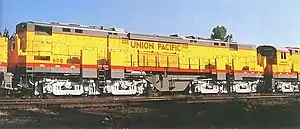ALCO Century 855
The ALCO Century 855 was a 5,500 hp (4,101 kW) diesel-electric locomotive built in 1964 by the American Locomotive Company for the Union Pacific Railroad. The locomotive was notable for being ALCO's most powerful diesel-electric locomotive and, at the time, the most powerful diesel locomotive ever built,[1] being surpassed by the 6,600 horsepower (4,922 kilowatts) EMD DDA40X in April 1969.
| ALCO Century 855 | |||||||||||||||||||||||||||
|---|---|---|---|---|---|---|---|---|---|---|---|---|---|---|---|---|---|---|---|---|---|---|---|---|---|---|---|
 | |||||||||||||||||||||||||||
| |||||||||||||||||||||||||||
| |||||||||||||||||||||||||||
| |||||||||||||||||||||||||||
| |||||||||||||||||||||||||||
| Stats given in this table pertain to cab unit | |||||||||||||||||||||||||||
History
Powered by a pair of 16 cylinder ALCO 251C diesel engines, and rated at 5,500 hp (4,101 kW), it was ALCO's answer to the EMD DD35A and the GE U50. The C855 rode on four two-axle trucks, grouped in pairs linked by span bolsters, giving a wheel arrangement of B+B-B+B. The trucks and bolsters were similar to those under UP's earlier turbine locomotives. Only two A units and one B unit were built, all for Union Pacific Railroad, which had also requested double-engined locomotives from EMD and GE in order to replace the turbines, which had become uneconomical to operate.[1]
Union Pacific also wished to reduce the number of locomotives needed on a consist, to keep in line with their allowable gross weight limit. By consolidating several locomotives into one or two, this allowed them to lower the axle load on the rails, but to stay within the limits placed by the company. They spent their lives in the general freight pool at North Platte; however, constant shutting down due to overheating & poor performance with its twin prime movers & twin engines led to their early retirement and eventual scrapping by February 1972, after only being in service for less than eight years.
References
- "6,000 HP Diesel-Electric for Fast Freight Traffic in USA" Railway Gazette July 3, 1964 pages 547-550
